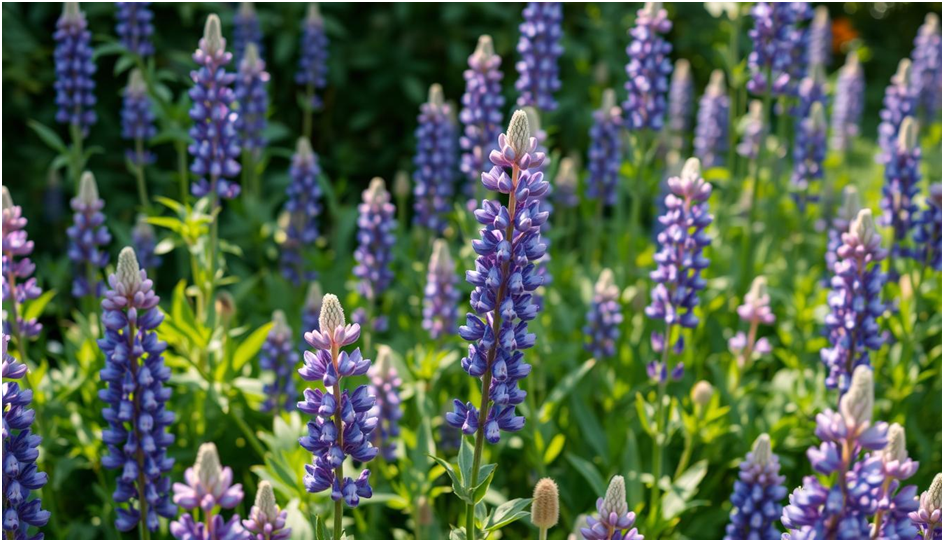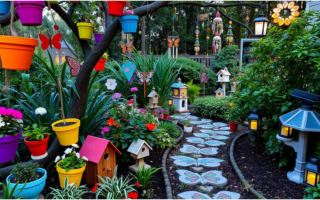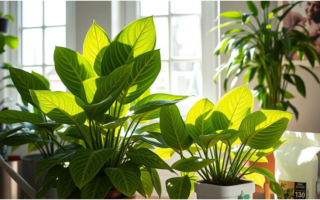Table of Contents
Thinking about how to make your outdoor space better? Wild lupine is a beautiful, pollinator-friendly plant to consider. It’s perfect for adding natural beauty to your yard. Its vibrant colors attract bees and butterflies, making it great for a thriving ecosystem.
Thank you for reading this post, don't forget to subscribe!Planting wild lupine brings stunning color to your yard and helps local wildlife. It’s easy to care for and grows well in many conditions. It’s ideal for those who want to beautify their garden or help pollinators.
Key Takeaways
- Wild lupine is a beautiful and pollinator-friendly plant that can add natural beauty to your yard.
- The lupin flower is a great choice for creating a thriving ecosystem.
- Wild lupine is low-maintenance and can thrive in a variety of conditions.
- Planting wild lupine can help support local wildlife.
- Wild lupine is an excellent option for busy homeowners looking to add some visual interest to their garden.
- The lupin flower can attract various species of bees and butterflies to your yard.
- Wild lupine is a great way to create a stunning display of color in your yard.
Understanding Wild Lupine: A Native American Beauty
Exploring native wildflowers, you’ll find lupinus perennis. It’s a species that has won many hearts with its beauty and strength. Native to North America, it’s been a key part of the ecosystem for centuries.
This wildflower thrives in many environments. You can find it in woodlands, prairies, and even by roadsides. Its tall spikes of colorful flowers and unique leaf shape make it a favorite among gardeners and nature lovers.
What Makes Wild Lupine Unique
So, what makes lupinus perennis special? Its deep taproots help it reach water and nutrients that others can’t. This makes it great for areas with poor soil. It also fixes nitrogen in the soil, improving soil health and fertility.
Natural Habitat and Distribution
In its natural habitat, lupinus perennis grows in various conditions. It prefers full sun to partial shade. Its range covers much of North America, from Canada to the southeastern United States. It’s a common sight in many areas, showing the diversity and richness of American flora.
| Characteristics | Description |
| Flower Color | Purple, Pink, White |
| Leaf Shape | Palmate, with 7-9 leaflets |
| Growth Habit | Upright, with tall spikes of flowers |
Historical Significance in North American Ecosystems
Throughout history, lupinus perennis has been important in North American ecosystems. It provides food and shelter for wildlife. Its beauty and uniqueness also make it a favorite for gardeners and landscape designers. They value its ability to attract pollinators and add color and texture to outdoor spaces.
Key Characteristics of Wild Lupine Plants
Understanding the key traits of wild lupine is crucial for plant identification. These plants stand out with their tall stems, reaching up to 2 feet. Their unique growth habits, leaf structure, and flower patterns make them easy to spot.
Here are some key traits to help identify wild lupine:
- Leaf structure: Wild lupine leaves are palmate, with 7-11 leaflets in a circular pattern.
- Flowering patterns: They have spikes of colorful flowers, ranging from pink to purple, and sometimes white.
- Growth habits: Wild lupine has a deep taproot, thriving in poor soil.
Knowing these traits helps you appreciate wild lupine’s beauty. Whether you’re a botany expert or new to plant identification, recognizing these features deepens your respect for this remarkable plant.
| Characteristic | Description |
| Growth Habit | Tall, upright stems up to 2 feet in height |
| Leaf Structure | Palmate leaves with 7-11 leaflets |
| Flowering Patterns | Spikes of colorful flowers in shades of pink, purple, and white |
Essential Growing Requirements for Wild Lupine Success
When you garden with wild lupine, knowing the right conditions is key. Wild lupine needs the right soil, sunlight, and water to thrive. By meeting these needs, you can enjoy its beautiful blooms and benefits in your garden.
First, think about the soil. Wild lupine likes well-draining soil that’s slightly acidic. You can test your soil to see if it’s the right pH. Adding compost can also make the soil better for your plants.
Soil Conditions and Preparation
- Test soil pH and amend if necessary
- Add organic matter like compost to improve soil structure and fertility
- Choose a location with well-draining soil to prevent waterlogged soil
Wild lupine also needs the right amount of sunlight and temperature. It does best in full sun to partial shade. It’s also sensitive to extreme weather, so protect it from harsh conditions. Knowing these needs helps you create the perfect spot for your wild lupine.
Water Requirements Throughout the Seasons
Watering is also important for wild lupine. During the growing season, keep the soil moist but not too wet. As the seasons change, adjust your watering to keep your wild lupine happy.
| Season | Watering Requirements |
| Spring | Consistent moisture |
| Summer | Regular watering, avoiding overwatering |
| Fall and Winter | Reduced watering, allowing soil to dry slightly |
The Environmental Impact of Wild Lupine in Your Garden
Wild lupine is a native wildflower that supports local pollinators and improves soil health. Adding it to your garden creates a haven for native wildlife. It helps make your ecosystem healthier. Native wildflowers like wild lupine are key for biodiversity and ecological balance.
Wild lupine offers many environmental benefits:
- Soil erosion prevention: Its deep taproot stabilizes soil and prevents erosion.
- Pollinator support: It’s a rich source of nectar and pollen, attracting bees and butterflies.
- Carbon sequestration: As a native wildflower, it absorbs carbon dioxide, reducing greenhouse gas emissions.
Planting wild lupine in your garden adds beauty and supports sustainability.
Every small change in your garden can have a big impact. By adding native wildflowers like wild lupine, you help create a balanced ecosystem. This benefits both you and the environment.
“By planting native wildflowers like wild lupine, we can help to preserve the natural beauty and biodiversity of our environment, while also promoting a healthier and more sustainable ecosystem.”
Seasonal Care and Maintenance Tips
To keep your wild lupine plants healthy, it’s key to give them the right care all year. Knowing what your plants need is crucial. The lupin flower adds beauty to any garden, but it needs attention to bloom fully.
In spring, focus on managing your plants’ growth. Remove dead or damaged leaves and support the stems as they grow. Fertilize with a balanced fertilizer to help them grow strong. As summer comes, your plants will bloom, showing off colorful flowers. Keep the soil moist but not too wet during this time.
Spring Growth Management
Here are some tips for spring growth management:
- Remove dead or damaged leaves to prevent disease
- Support the stems to prevent them from becoming leggy
- Fertilize with a balanced fertilizer for healthy growth
Summer Blooming Period
During the summer, keep the soil moist. Deadheading the flowers will encourage more blooms and prevent seed production.
Fall and Winter Care
In fall and winter, water less, once a month, and don’t fertilize. Cut back the stems after the first frost to prepare for the next season. By following these tips, your wild lupine plants will stay healthy and bloom beautifully for years.
| Season | Care and Maintenance Tips |
| Spring | Manage growth, remove dead foliage, fertilize |
| Summer | Keep soil consistently moist, deadhead flowers |
| Fall and Winter | Reduce watering, avoid fertilizing, cut back stems |
Companion Planting with Wild Lupine
Companion planting with wild lupine can make your garden beautiful and healthy. This native wildflower attracts beneficial insects and pollinators. It’s a great choice for any garden.
Plants like bee balm, black-eyed susans, and coneflowers go well with wild lupine. They add beauty and provide food and shelter for wildlife. This creates a balanced and harmonious garden ecosystem.
Here are some benefits of companion planting with wild lupine:
- Improved soil health: Wild lupine’s deep taproot breaks up soil and brings up nutrients, helping other plants.
- Increased biodiversity: Planting native wildflowers like wild lupine attracts many pollinators and beneficial insects.
- Enhanced beauty: Companion planting with wild lupine adds color, texture, and interest to your garden.
Choosing the right companion plants for wild lupine can make your garden thrive. It showcases the beauty of this native wildflower.
Common Challenges and Solutions in Wild Lupine Cultivation
Wild lupine care comes with its own set of challenges and solutions. As you explore lupinus perennis, you’ll face obstacles that affect your plants’ health and growth.
Pest management is a big concern. Aphids, whiteflies, and spider mites can harm your plants. Use organic pest control like neem oil or insecticidal soap. Check your plants often and separate any infested areas to stop pests from spreading.
Pest Management and Disease Prevention
- Use neem oil or insecticidal soap to control pests
- Isolate infested areas to prevent the spread of pests
- Implement good hygiene practices, like washing your hands before handling plants
Disease prevention is also key. Fungal diseases like powdery mildew and root rot can harm lupinus perennis. Ensure good air flow and avoid overwatering. Organic fungicides can also help.
Growth Issues and Remedies
Growth problems can stem from poor soil, not enough sunlight, or bad watering. Check your soil and adjust it for lupinus perennis. Make sure your plants get enough sunlight and water them right. With these tips, you can overcome challenges and enjoy a successful wild lupine cultivation.
| Challenge | Solution |
| Pest infestation | Use organic pest control methods |
| Disease | Implement good hygiene practices and use fungicides |
| Growth issues | Assess and adjust soil conditions, provide sufficient sunlight and water |
Design Ideas for Incorporating Wild Lupine in Various Landscape Styles
Wild lupine offers endless possibilities for your garden. Plant it with native flowers like black-eyed susans and coneflowers for a stunning meadow. This combo attracts pollinators and adds vibrant colors to your space.
For a modern twist, try wild lupine in a container garden. This setup lets you control soil and sunlight, making care easier. Pair it with plants like bee balm and blazing star for a harmonious look.
- Make a wildflower border along fences or paths.
- Plant it in a rock garden or alpine bed.
- Use it as a groundcover in woodland gardens.
Adding wild lupine to your garden makes it beautiful and unique. It attracts pollinators and brings color and interest to your outdoor area. Whether you want a modern container garden or a traditional meadow, wild lupine is a great choice.
Transform Your Garden into a Native Wildlife Haven with Wild Lupine
By adding wild lupine to your garden, you create a haven for native wildlife. This beautiful perennial plant brings color and texture to your garden. It also provides food and shelter for many local pollinators and creatures.
When you add lupin flowers to your garden, you’ll see butterflies and bees buzzing around. It’s a joy to watch your garden come alive with these important species. You’ll also help protect your local ecosystem.
Start making your garden a natural oasis by using wild lupine in creative ways. It can be a focal point, part of a wildflower meadow, or enhance your garden design. This plant will become a treasured part of your garden, supporting both you and the wildlife it attracts.
FAQ
What is wild lupine?
Wild lupine, also known as Lupinus perennis, is a native North American wildflower. It grows in open forests, meadows, and grasslands. This perennial plant blooms with vibrant, pea-like flowers in colors like blue, purple, pink, and white.
What makes wild lupine unique?
Wild lupine is special because it’s a legume. This means it can fix nitrogen in the soil, making it great for gardens. It also attracts native pollinators like bees, butterflies, and hummingbirds.
Where does wild lupine grow naturally?
Wild lupine grows in North America, including the eastern and central United States, and parts of Canada. It likes well-drained, sandy or gravelly soils and full sun to partial shade.
What are the key characteristics of wild lupine plants?
Wild lupine plants are 1 to 3 feet tall. They have palmate-shaped leaves with 5 to 11 leaflets. The plant’s tall, upright flower spikes can reach 2 feet, with vibrant, pea-like flowers.
What soil and environmental conditions does wild lupine need to thrive?
Wild lupine needs well-drained, sandy or gravelly soils with a neutral to slightly acidic pH. It prefers full sun to partial shade and can handle various temperatures. Consistent moisture is key, especially when it’s blooming.
How does wild lupine benefit the environment?
Wild lupine supports local ecosystems and wildlife. Its nectar-rich flowers feed pollinators like bees, butterflies, and hummingbirds. It also improves soil health, helping other native plants grow.
How should I care for wild lupine throughout the seasons?
Caring for wild lupine varies by season. In spring, manage new growth and remove dead foliage. In summer, enjoy the blooms and deadhead spent flowers. In fall and winter, cut back foliage and mulch to protect roots.
What are some good companion plants for wild lupine?
Wild lupine looks great with native plants like coneflowers, black-eyed Susans, and grasses. These plants create a beautiful, balanced garden that attracts many pollinators and wildlife.
What common challenges may I face when growing wild lupine?
Growing wild lupine can be challenging due to pests, diseases, and growth issues. Aphids, leaf miners, and fungal diseases like powdery mildew are common. Good soil health and air circulation can help solve these problems.
How can I incorporate wild lupine into my landscape design?
Wild lupine fits well in many landscape styles, from naturalistic meadows to formal gardens. Use it as a focal point, in mass groupings, or in mixed borders for a vibrant, pollinator-friendly display.













